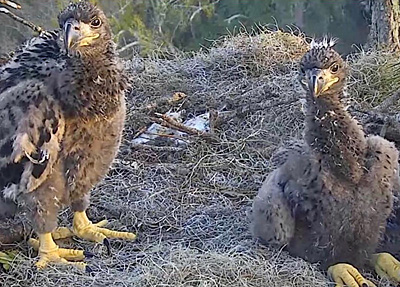As we approach weeks five and six of the eaglet’s life at Dulles Wetlands, many changes continue, and the eaglet begins to take on a look that is more like a full-grown Bald Eagle. Feathers are coming in, new skills are being developed and less parent supervision is needed.
Week 5 (29 to 35 days)
- If there were more than one eaglet, sibling rivalry would decrease, though food competition remains throughout the eaglets’ time on the nest and beyond
- An eaglet:
- Begins playing with sticks
- Is capable of fully standing
- Is aware of its surroundings, in and outside the nest
- Begins tracking objects and birds outside the nest
- The tarsi (the feet or lowest part of the legs) are full size, and the foot pad is nearly full size
- Imprinting is nearly complete

Photo courtesy of American Eagle Foundation
Week 6 (36 to 42 days)
- Dark juvenile feathers are growing in, changing the appearance of the eaglet
- An eaglet:
- Is nearly as large as the parent
- Is very proficient at standing and walking
- Starts attempting to tear at food, which requires the eaglet to learn to use its foot and talons to hold the food down
- Imitates parents in nest duties, moving sticks, arranging nesting material
- Spends a lot of time preening its feathers
- Begins holding things in its talons, learning to grasp and let loose
- Begins flapping its wings and building the muscles needed for flying
- Most of the growth now taking place is feather growth
- The parents decrease their time at the nest, with the eaglet being on its own more
References:
American Eagle Foundation
Raptor Resource Project

